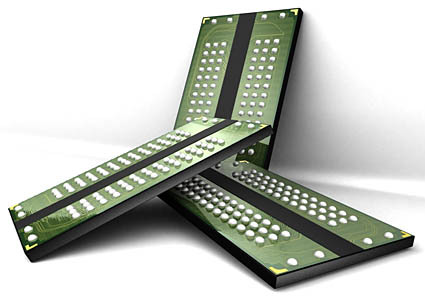Micron samples DDR3 memory
Boise (ID) - Micron is the second major DRAM manufacturer to announce sample shipments of next-generation DDR3 modules and claims to be the first company to ship 1 Gb devices with a capacity of up to 2 GB. DDR3 promises to double the speed of today's DDR2 memory and is expected to become available on high-end desktop computers in late 2007.
The transition from DDR1 to DDR2 SDRAM memory began more than three years ago with Hynix' development of the first 1 Gb DDR2 memory device in August of 2003 and recently has entered its last phase with AMD's introduction of the Socket AM2 processor series. And AMD's support of DDR2-800 memory will be the final stage of mainstream devices as the next DDR generation is appearing on the Horizon.
Following the announcements of Samsung's prototypes and Elpida's sample shipments to Intel, Micron today said that it is making samples of its 1 Gb DDR3 memory chips and modules generally available. The devices are built in a 78 nm manufacturing process and are shipping in capacities of 512 MB, 1 GB and 2 GB. Versions initially available include DDR3-800 and DDR3-1066. Micron said there may be limited yields of DDR3-1333 available.
Rendering of Micron DDR3 chips
DDR3 is expected to scale up to 800 MHz, which will result in a DDR3-1600 designation and offer twice the speed of today's DDR2-800 devices. Micron claims that such a device will be able to transfer a 100,000 page document in about one second.
The value of DDR3 to end-users is non-existent at this time as there are no commercial platforms available that support the standard. However, industry sources told TG Daily that chip developers, including Intel, are already developing DDR3 platforms for debut next year. Intel, has been receiving DDR3 from Elpida since November of last year, plans to introduce first desktop chipsets that support DDR3 in the second half of next year. Roadmaps suggest that the company plans to use DDR2 and DDR3 as coexisting technologies for about a year and completely rely on DDR3 beginning in 2009. DDR3-1333 will become Intel's standard memory technology in late 2008.
Besides more performance, DDR3 also provides an advantage in power consumption, as the supply voltage drops from 1.8 volts in DDR2 to 1.5 volts in DDR3. However, this benefit will be limited as overall power consumption will rise with increasing clock speed: While DDR3-800 will consume less power than DDR2-800, a DDR3-1600 solution will consume substantially more power than the fastest mainstream memory today, Micron said.
Get Tom's Hardware's best news and in-depth reviews, straight to your inbox.
Although current sample capacities of DDR3 modules are limited to 2 GB, Micron says that a 1 Gb density level will enable memory manufacturers to push the envelope to 4 GB down the road. The company also develops a 2 Gb technology for the server market, which will pave the way for more affordable 8 GB server modules - which currently sell for at least $2000. The highest-capacity DRAM module currently offered is a Micron-built 16 GB DDR2 device.
Micron plans to begin mass production of DDR3 memory in the second quarter of next year.
Tom's Hardware is the leading destination for hardcore computer enthusiasts. We cover everything from processors to 3D printers, single-board computers, SSDs and high-end gaming rigs, empowering readers to make the most of the tech they love, keep up on the latest developments and buy the right gear. Our staff has more than 100 years of combined experience covering news, solving tech problems and reviewing components and systems.


